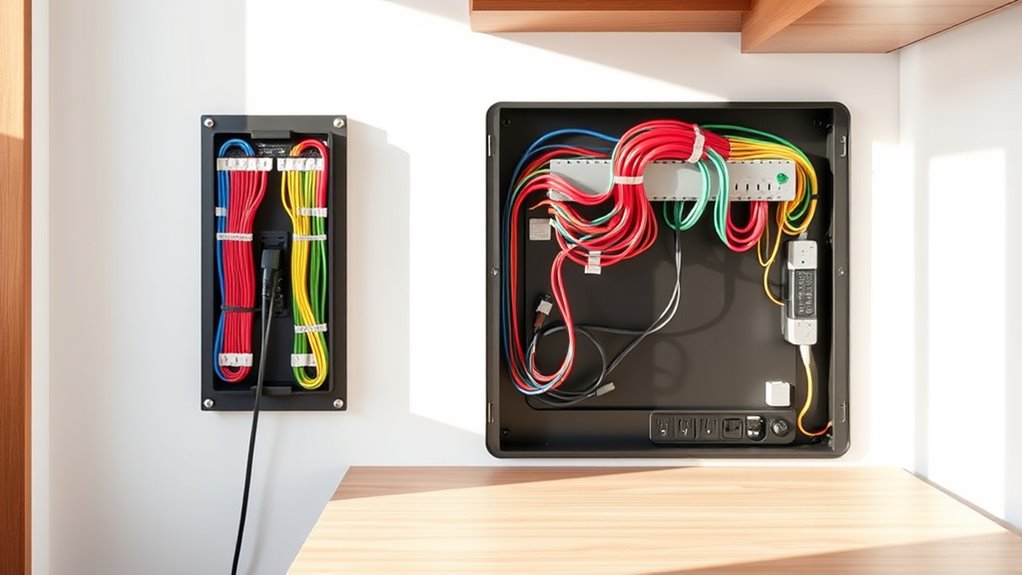To guarantee a safe electrical setup in your compact home, prioritize strategic outlet placement near high-traffic areas and use high-quality wiring suited for your needs. Keep cords organized and avoid overloading circuits by distributing the electrical load evenly. Install dedicated circuits for powerful appliances, regularly inspect for damage, and ensure outlets and switches are properly grounded and secure. If you want to learn more about creating a safe, efficient system, continue exploring effective electrical practices.
Key Takeaways
- Strategically place outlets near high-use areas, avoiding extension cords and overloading circuits.
- Use high-quality wiring, secure grounding, and protect cables in moisture-prone or high-traffic zones.
- Distribute electrical load evenly and install dedicated circuits for high-power appliances.
- Keep wiring organized, neat, and regularly inspect for wear or damage to ensure safety.
- Ensure outlets and switches are properly grounded and securely mounted to prevent electrical hazards.

Setting up the electrical system for a compact home requires careful planning to maximize safety and efficiency. Since space is limited, you need to think strategically about appliance placement to minimize clutter and reduce the risk of overloaded circuits. Position outlets near high-usage areas like the kitchen, bathroom, and living space, ensuring you don’t stretch cords across walkways or furniture. This approach not only keeps your home organized but also prevents tripping hazards and accidental disconnections. When placing appliances, consider their power needs and avoid crowding outlets, which can lead to overloads and potential electrical fires. Proper appliance placement helps distribute electrical load evenly, maintaining safety and preventing unnecessary strain on your wiring system.
Wiring safety is paramount in a compact home, where tight spaces can make troubleshooting and repairs more challenging. Always use high-quality wiring suited for your home’s electrical demands, and plan your wiring routes carefully to avoid sharp bends or pinched cables that could cause damage over time. When installing outlets and switches, ensure they are securely mounted and grounded correctly. Grounding provides a safe pathway for excess current, reducing the risk of electric shocks. In a small space, it’s especially vital to keep wiring neat and organized, avoiding tangled or exposed cables that could become hazards. Use conduit or protective tubing where necessary, especially in areas prone to moisture or physical damage, such as kitchens or bathrooms. Additionally, proper wiring practices are essential to ensure long-term safety and reliability of your electrical system.
Moreover, consider the overall electrical load of your home. Calculate the wattage of all appliances you plan to use simultaneously, and design your wiring system accordingly. Installing a dedicated circuit for high-power appliances like refrigerators or space heaters can prevent overloads that trip breakers or cause electrical faults. Use circuit breakers with appropriate ratings and label them clearly, so you know which circuit powers which part of your home. This organization simplifies troubleshooting and enhances safety. Regularly inspecting wiring and outlets for signs of wear or damage is also essential, particularly in a compact setting where accessibility might be limited. Promptly addressing issues like frayed cables or scorch marks can prevent potential hazards from escalating.
Frequently Asked Questions
What Are the Most Common Electrical Issues in Small Homes?
You often face electrical issues like overloaded circuits, faulty wiring, or tripped breakers in small homes. These problems threaten electrical safety and can cause fires or outages. Regular wiring maintenance helps prevent hazards, ensuring your system remains safe and efficient. By paying attention to signs like flickering lights or warm outlets, you can spot issues early, maintain electrical safety, and keep your home running smoothly.
How Often Should I Have My Electrical System Inspected?
Think of your electrical system as the heartbeat of your home; it needs regular checkups to stay healthy. You should schedule an inspection at least every 3-5 years, or sooner if you notice flickering lights or circuit issues. Following a consistent maintenance schedule keeps your system reliable, prevents surprises, and guarantees safety. Don’t wait for sparks—proactive inspections are your best defense against electrical mishaps in your cozy home.
Can I Upgrade My Electrical Panel Myself Safely?
You shouldn’t attempt DIY upgrades to your electrical panel, as electrical safety is vital. Upgrading your panel involves working with high voltage and requires specialized knowledge and tools. If you’re considering an upgrade, it’s best to hire a licensed electrician who can guarantee the job is done safely and up to code. Always prioritize safety over DIY projects, especially when dealing with electrical systems in compact homes.
What Are the Signs of Faulty Wiring in a Compact Home?
You’ll notice faulty wiring in your compact home if you see wiring discoloration or frequent tripping of circuit breakers. Discolored wires, often black or brown, indicate overheating or burning. Frequent tripping suggests overloaded circuits or loose connections. Pay attention to flickering lights or outlets that feel warm. If you observe these signs, it’s vital to have a licensed electrician inspect and repair your wiring promptly to guarantee safety.
Are Energy-Efficient Appliances Safer for Small Electrical Systems?
Energy-efficient appliances are generally safer for small electrical systems because they draw less power, reducing the risk of overloads and electrical faults. Their improved design often includes better insulation and safety features, enhancing appliance safety. However, you should still guarantee that the appliances are compatible with your home’s electrical capacity and installed correctly. Regularly checking for signs of wear and following manufacturer instructions will help maintain a safe, efficient setup.
Conclusion
Ultimately, setting up your compact home’s electrical system is like planting a well-organized garden—you need careful planning and attention to detail. By choosing the right wiring, installing safety devices, and staying mindful of load limits, you guarantee a safe and efficient space. Remember, a safe electrical setup is the backbone of a cozy, worry-free home. Keep your system tidy and up-to-date, and you’ll enjoy peace of mind like a calm lake on a quiet day.









